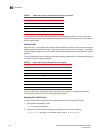
100 Dell Converged Enhanced Ethernet Administrator’s Guide
53-1002116-01
Congestion control
10
Congestion control
Queues can begin filling up due to a number of reasons, such as over subscription of a link or
backpressure from a downstream device. Sustained, large queue buildups generally indicate
congestion in the network and can affect application performance through increased queueing
delays and frame loss.
Congestion control covers features that define how the system responds when congestion occurs
or active measures taken to prevent the network from entering a congested state.
Tail drop
Tail drop queueing is the most basic form of congestion control. Frames are queued in FIFO order
and queue buildup can continue until all buffer memory is exhausted. This is the default behavior
when no additional QoS has been configured.
The basic tail drop algorithm does not have any knowledge of multiple priorities and per traffic
class drop thresholds can be associated with a queue to address this. When the queue depth
breaches a threshold, then any frame arriving with the associated priority value will be dropped.
Figure 6 describes how you can utilize this feature to ensure that lower priority traffic cannot totally
consume the full buffer memory. Thresholds can also be used to bound the maximum queueing
delay for each traffic class. Additionally if the sum of the thresholds for a port is set below 100
percent of the buffer memory, then you can also ensure that a single port does not monopolize the
entire shared memory pool.
FIGURE 6 Queue depth
The tail drop algorithm can be extended to support per priority drop thresholds. When the ingress
port CoS queue depth breaches a threshold, then any frame arriving with the associated priority
value will be dropped. Figure 6 describes how you can utilize this feature to ensure lower priority
traffic cannot totally consume the full buffer memory. Thresholds can also be used to bound the
maximum queueing delay for each traffic class. Additionally if the sum of the thresholds for a port
is set below 100 percent of the buffer memory then you can also ensure that a single CoS does not
monopolize the entire shared memory pool allocated to the port.


















